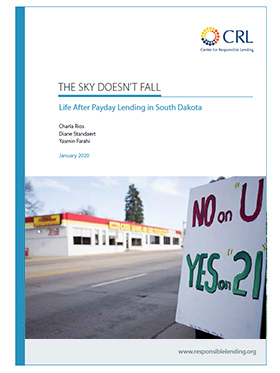For more than a decade, payday loans, car-title loans, and high-cost installment loans in South Dakota have carried charges exceeding 300% annual percentage rate (APR). In 2016, South Dakotans approved lowering the cost of payday loans, car-title loans, and installment loans to an annual interest rate cap of 36%, inclusive of all fees and charges. The vote in favor of the rate cap was overwhelming. In policy discussions about highcost small dollar lending, one of the most frequently asked questions is: what happens when a state enacts a rate cap? This paper seeks to add to this body of knowledge by providing insight into how consumers, communities, and credit availability are faring in South Dakota, two years after the enactment of a rate cap.
In this paper, we review several data sources including loan usage rates, small claims files, credit data (such as the volume of Payday Alternative Loans and unsecured loans), polling of South Dakotans’ views after the passage of the rate cap, and community interviews. These community interviews also formed the content of the documentary, Let My People Go: South Dakotans Stop Predatory Payday Lending.
This work in South Dakota provides an example of a community-driven, state-level reform effort. Its story provides a template of how other states can contemplate and potentially achieve a 36% rate cap. It shows positive developments after the passage of a rate cap, including continued lending by banks and credit unions; redevelopment of former payday loan storefronts; and widespread support for the 2016 reforms. Finally, this paper contrasts current developments at the federal level which seek to favor payday lenders and threaten to override state laws like South Dakota’s voter-affirmed rate cap. For example, if allowed by federal regulators, rent-a-bank schemes would enable high-cost lenders to evade rate caps and remove state control, leaving millions of people vulnerable to the harms of high-cost lending—even when it directly contradicts the affirmative public policy decisions of their home states.
Key Findings of This Report Include
- Payday lending causes immediate and long-term harms through high interest rates, forced reliance on the loan product, and consequences of debt collection that last years beyond the original loan term.
- Other options are available to South Dakotans following the 36% rate cap, including small dollar loans and other financial strategies.
- Storefronts formerly occupied by payday lenders that extracted millions in wealth from South Dakotans, now are revitalized as restaurants, churches, credit unions, and other community contributing businesses. With the rate cap in place, South Dakotans save $81 million a year annually in fees that would have otherwise been paid on high-cost loans.
- Two years after the enactment of the rate cap (2018), South Dakotans still show continued strong support for 36%. Both borrowers and voters show strong concern if the South Dakota legislature were to repeal the 36% rate cap.
